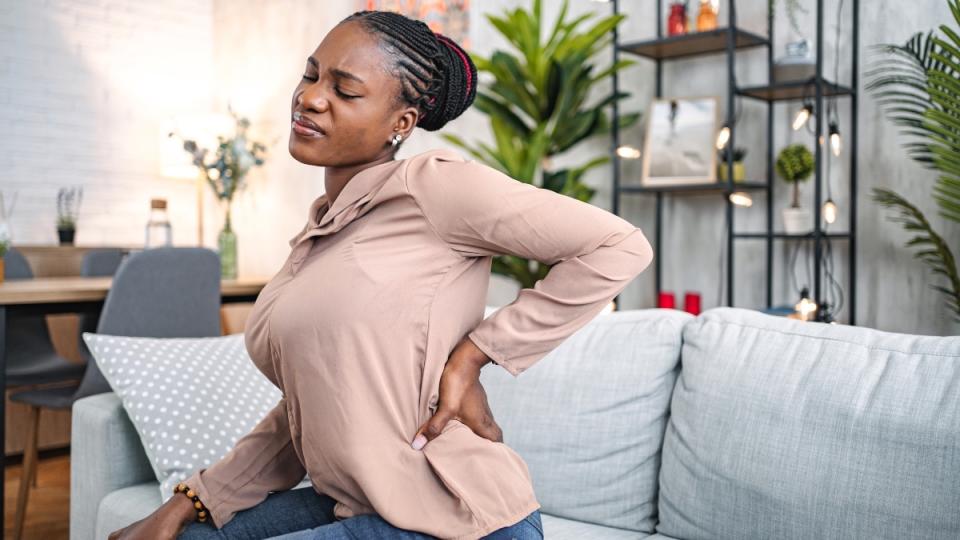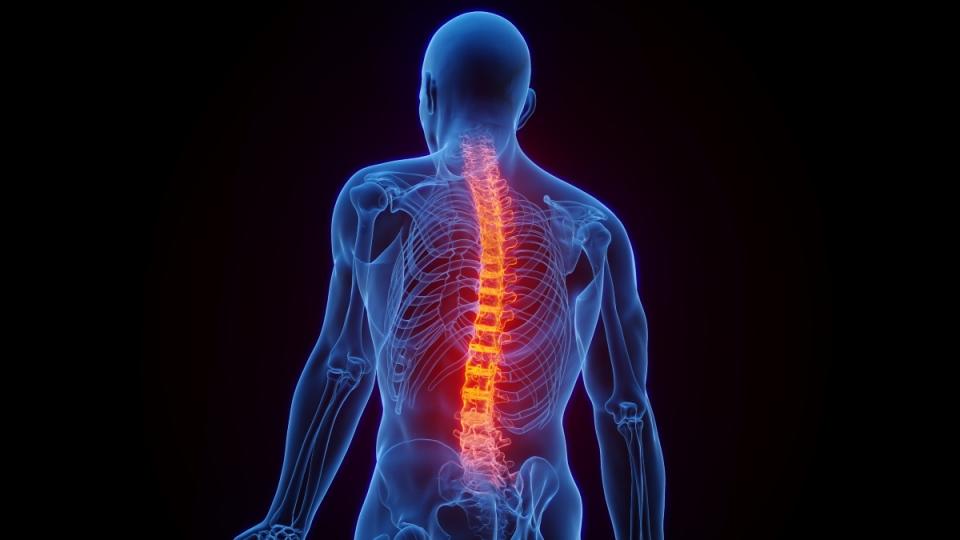4 Ways to Speed-Heal a Pulled Muscle in Your Back + Why Leg Stretches Can Help
We know how to protect ourselves from bigger injuries — wearing a helmet while biking, holding the railing while walking down the stairs, choosing comfortable, supportive shoes. But sometimes, it’s hard to avoid the smaller injuries. One example: A pulled muscle in your back, which can happen from simply reaching for the flour on the top shelf of the pantry. Here, we’re sharing everything you need to know about this common injury, including how you can reduce your risk and how to treat it at home.
What is a pulled muscle?
The term pulled muscle is a bit of a catch-all, referring to a swath of different injuries. “A pulled muscle, or muscle strain, is an injury to a muscle or a tendon, which is the tissue that connects muscle to bone,” explains John Buza, MD, an orthopedic spine surgeon at Och Spine at New York-Presbyterian Queens. “These can range from minor injuries, such as overstretching a muscle, to more serious injuries, such as partial or complete muscle tears.” As such, it’s possible to pull a muscle anywhere on your body, but some areas are more prone to injury than others.
A pulled muscle in your back is common
“The back is one of the most common places to experience a pulled muscle,” says Dr. Buza. That’s because it’s involved in so many movements and activities, from walking or cooking to folding laundry or gardening.
“Sports injuries, such as weightlifting, tennis and golf are common causes of a pulled muscle, along with shoveling snow or lifting a heavy box,” notes Christine Goertz, DC, PhD, a professor in musculoskeletal research at the Duke Clinical Research Institute and Vice Chair for Implementation of Spine Health Innovations in the Department of Orthopedic Surgery at Duke University.
Things you do on a daily basis can also lead to a pulled muscle in your back. “It is possible to pull a muscle from everyday activities like stepping off a curb or leaning forward over a sink,” Dr. Buza notes.

If you do pull a muscle in your back, chances are it’s in the lower part. “The low back is the most common area of your back to experience a pulled muscle, as it supports the weight of your entire upper body and is involved in bending, lifting and twisting,” explains Dr. Buza. “The extensor muscles of the lower back are prone to muscle strain, especially with a weak core or tight hamstrings.”
Related: Lower Back Pain Self-Care Remedies That Top Docs Use Themselves to Get Relief Fast
What a pulled muscle in your back feels like
Regardless of how severe the muscle strain is, when it happens, you’ll know. Pulling a muscle is usually accompanied by a sharp burst of pain. Afterwards, you’ll be able to tell how severe the injury is by how much you’re able to move. With a mild strain, you should still be able to do most activities, the muscles will just feel tight or knotted. But if the pull is severe, you’ll hardly be able to move at all.
“The pain should improve after one to two weeks, but some back stiffness may be present for up to four to six weeks,” says Dr. Buza. “If the pain does not improve in one to two weeks, is severe or travels to your abdomen or down your legs, you should consult your physician.”
Risk factors for a pulled muscle in your back
There are a few factors that experts say increase your risk of pulling a muscle in your back. They include:
1. Age
“The risk of a pulled muscle does increase as you age,” notes Dr. Buza. “This is partly due to degenerative changes in the spine which happen as we age, including degenerated discs, osteoporosis or pinched nerves.” Indeed, experts estimate that up to 90% of people will show signs of degenerated discs, or osteoarthritis of the spine, by age 60. (Discover easy ways to ward off osteoporosis.)

SEBASTIAN KAULITZKI/Getty
Similar age-related declines can happen in the health of the muscles, too. “Muscle mass and strength both decrease with age, beginning as early as our 30’s and 40’s,” explains Dr. Goertz. “This process tends to accelerate after the age of 65 and may contribute to an increased frequency of back pain as we get older.” Known as sarcopenia, this decline in muscle mass with age can make your muscles more prone to injury, especially strains from everyday activities.
2. Sitting too much
“Prolonged sitting, especially in a slouched position, can lead to a weakened core and tight hamstrings and may increase the risk of a pulled muscle,” Dr. Buza says. Spending too much time in a slouch or other unnatural or poor posture, puts extra strain on the spine and back muscles, upping the likelihood of an injury.
3. General inactivity
Simply put, the less you use your muscles, the more likely you are to injure them. A review in Scientific Reports found that people who were regularly active at a medium level of intensity (activities in which you break a sweat, but you can still carry a conversation) had a significantly lower risk of developing low back pain than those who were not active.
4 self-care remedies for a pulled muscle in your back
The pain of a pulled muscle should naturally ease within a week or two. But in the meantime, these smart strategies can help you recover faster.
1. Take it easy
Even if you don’t think you “did anything serious” to your back, it’s important to take it easy immediately after pulling a muscle. “The pain can be intense for the first few days after pulling a muscle in your back,” notes Dr. Buza. “During this time, avoid strenuous activities such as bending and lifting, which may make the back pain worse.”

2. Walk it out
While you should avoid overexerting yourself, relaxed strolls help speed healing. “It is important to continue to walk for exercise, which can increase the blood flow to your low back and reduce the pain,” Dr. Buza says. A review in Disability and Rehabilitation confirmed that walking improves pain, disability and quality of life and in people with lower back pain.
3. Stretch your legs and core
“As the pain subsides after the first few days, simple stretching and strengthening exercises may help,” says Dr. Buza. “This would include gentle hamstring stretching or core exercises, such as modified planks.” What do your legs and core have to do with your back? Relaxing tight hamstrings relieves pressure on your low back, while strengthening your core acts almost like scaffolding to support your spine. (See how stretching can ease upper back pain, too.)
To stretch your hamstrings without putting too much strain on your back, try placing your heel on a low stool or chair and bending at the waist toward the leg until you feel a stretch in your hamstring. For a modified plank, start on your hands and knees. Slowly slide your knees back, keeping them on the ground, until your body is in a straight line from your shoulders to your knees. Check out the video below for a visual how-to:
4. Heat it up
“Superficial heat using a heating pad or warm bath can help,” says Dr. Goertz. Like walking, heat can help increase blood flow to the area to speed healing. It also helps loosen the muscles to minimize pain. Aim for about 20 minutes of heat at a time. (Learn how to use heat and ice to ease mid back pain.)
For more ways to soothe back pain:
Lower Back Pain Self-Care Remedies That Top Docs Use Themselves to Get Relief Fast
What Causes Mid Back Pain + the Easy Shoulder Squeeze That Makes It Go Away
Starting Your Day With This One Simple Move Thwarts Upper Back Pain, Doctor Says
This content is not a substitute for professional medical advice or diagnosis. Always consult your physician before pursuing any treatment plan.

